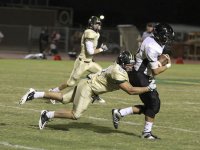Full-Contact Teaching: Connecting with Hearts and Minds
Last week our school celebrated homecoming football week. All week long, students, teachers and community members participated in pep rallies, parades, and school decoration, while the football teams unceasingly practiced. The much-anticipated homecoming game was well attended, even in pouring rain. For the fans, their excitement was as palpable as their soggy shoes and wet clothing. The real exciting things, however, were occurring on the muddy field below. Both teams were engaged in a physical and mental contest, aided by their coaches, but carried out entirely by the athletes.
The athletes demonstrated their prowess in handling the ball and the opposing teams, just as they had practiced so often. Adjustments had to be made mid-stream in order to find the right plays that would work against their opponent's defense. In this case, because of the weather, "up-the-middle" running plays were the favorite of our team, while the opposing team frequently took our players by surprise with "quarter back hand-offs." Being a full-contact sport, football enjoys a wide audience. Full contact requires the mind, the body and the heart and soul of an athlete.
As teachers, we are engaged in a "full-contact" competition. We are competing for the attention and academic success of our students and it requires our minds, bodies, and our entire heart and soul to be successful.
We are approaching our first full six weeks grading period and it is obvious that the initial excitement and enthusiasm of the beginning of school is wearing off. The daily grind of lesson planning, preparation, grading, and discipline takes its toll on us as if we were front-linemen. But every day we "suit-up" and keep at it. But to win our full-contact sport requires more than blocking and controlling the students' behaviors. We have to make contact with student's minds. Ok, that sounds a bit trite, but it is true. The real trick is how to do it.
I was in a history class yesterday and witnessed a teacher being successful at this. He was energetic and enthusiastic, and he was sharing with the students his eclectic wealth of knowledge. He made connections to why history was important for students to understand and how historical events prompted significant consequences in the world. A few weeks ago, I saw physics teachers with their students in the hallways, on the floor, lining up dominoes so the students could explore the equations related to time and motion. I saw Spanish teachers, while speaking no English, engage students in Spanish during the 16th of September commemorations by organizing cultural food potlucks and dealing with the full-contact mess and cleanup.
Full-contact teaching also involves targeting individual students that need help, finding out what their challenges are, getting to know them, and offering invitations and opportunities to succeed. Yes, RTI comes into play here, and so does differentiated instruction. But there is still more.
If each teacher would pick five students that are struggling in their class and do extra to make them successful, (doing what we know works -- calling home, praise, individual attention, tutoring, targeted instruction, etc.), then we will start seeing some real progress in those students. Once we get them going, then we choose five more. Just as in full-contact football, in full-contact teaching, we have to deal with what is in front of us, one thing (or five things) at a time.
Our team won the game, and the exuberance still lingers. Our teachers preparing for the final grades and exams, still feel the excitement of rolling up their sleeves and facing instructional challenges head on, and are looking forward to their students performing beyond expectations. After all is said and done, the scars and bruises gained from full-contact instruction (and sports) are worth it. Please share your full-contact teaching experiences.
